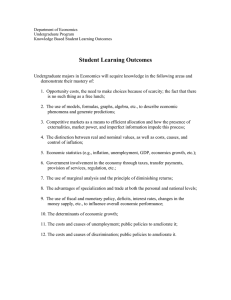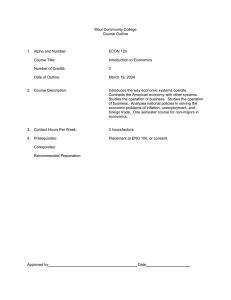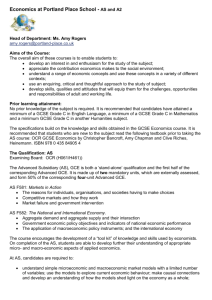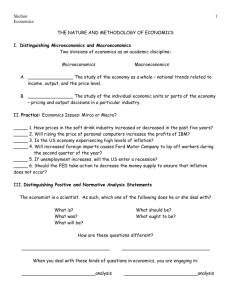Unit F582 - The national and international economy - Scheme of work and lesson plan (DOC, 286KB)
advertisement
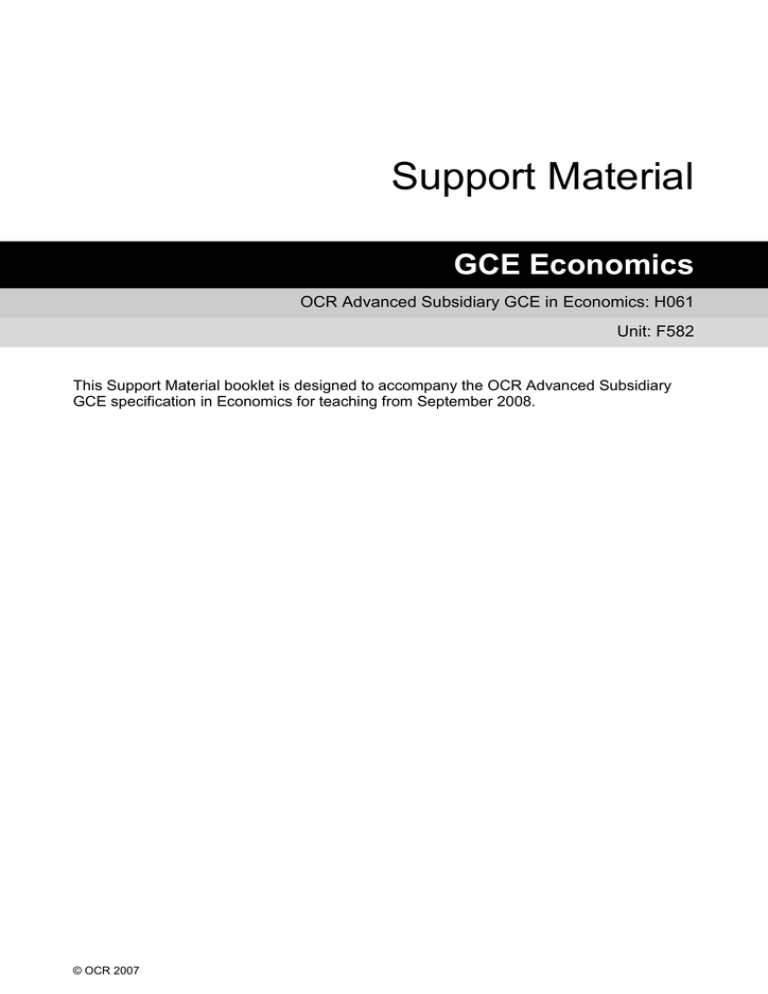
Support Material GCE Economics OCR Advanced Subsidiary GCE in Economics: H061 Unit: F582 This Support Material booklet is designed to accompany the OCR Advanced Subsidiary GCE specification in Economics for teaching from September 2008. © OCR 2007 Contents Contents 2 Introduction 3 Economics H061: The National and International Economy F582 5 Lesson Plan: Economics H061 The National and International Economy F582 17 Other forms of Support 18 2 of 19 GCE Economics Introduction Background A new structure of assessment for A Level has been introduced, for first teaching from September 2008. Some of the changes include: The introduction of stretch and challenge (including the new A* grade at A2) – to ensure that every young person has the opportunity to reach their full potential The reduction or removal of coursework components for many qualifications – to lessen the volume of marking for teachers A reduction in the number of units for many qualifications – to lessen the amount of assessment for learners Amendments to the content of specifications – to ensure that content is up-to-date and relevant. OCR has produced an overview document, which summarises the changes to Economics. This can be found at www.ocr.org.uk, along with the new specification. In order to help you plan effectively for the implementation of the new specification we have produced this Scheme of Work and Sample Lesson Plans for Economics. These Support Materials are designed for guidance only and play a secondary role to the Specification. Our Ethos All our Support Materials were produced ‘by teachers for teachers’ in order to capture real life current teaching practices and they are based around OCR’s revised specifications. The aim is for the support materials to inspire teachers and facilitate different ideas and teaching practices. Each Scheme of Work and set of sample Lesson Plans is provided in: PDF format – for immediate use Word format – so that you can use it as a foundation to build upon and amend the content to suit your teaching style and students’ needs. The Scheme of Work and sample Lesson plans provide examples of how to teach this unit and the teaching hours are suggestions only. Some or all of it may be applicable to your teaching. The Specification is the document on which assessment is based and specifies what content and skills need to be covered in delivering the course. At all times, therefore, this Support Material booklet should be read in conjunction with the Specification. If clarification on a particular point is sought then that clarification should be found in the Specification itself. GCE Economics 3 of 19 A Guided Tour through the Scheme of Work = Innovative Teaching Idea All the teaching ideas contained in the SOW are innovative, but the icon is used to Highlight exceptionally innovative ideas. = Stretch & Challenge Activity This icon is added at the end of text when there is an explicit opportunity to offer Stretch and Challenge. = ICT Opportunity This icon is used to illustrate when an activity could be taught using ICT facilities. 4 of 19 GCE Economics Economics H061: The National and International Economy F582 Suggested teaching time 15 hours Topic outline Topic Aggregate demand and aggregate supply and their interaction Suggested teaching and homework activities Suggested resources Aggregate demand Recap concept of macroeconomics. Explore the meaning and components of aggregate demand. Students to calculate the percentage contribution of the components of aggregate demand of different countries. PowerPoint slides/OHT/board work. The Economist Pocket World in Figures latest edition. Determinants of the components of aggregate demand Highlight key determinants. Students to undertake activities in the OCR textbook. Divide the class into 4 groups. Each group to research in more depth one of the determinants and then report back to the class on their answers to the activities and on the determinants. A homework assignment might be set requiring students to word process their findings for the rest of the class. PowerPoint slides/OHT/board work. OCR AS Economics by C.Bamford and S.Grant. AS Economics by S.Grant. The National Economy in a Global Context by C.Bamford and S.Grant. Shifts in the AD curve Students to draw diagrams to illustrate the effect of a cut in income tax and a rise in the rate of interest. PowerPoint slides/OHT/board work describing the relationship between AD and the price level and explaining one cause of a shift in the AD curve. = Innovative teaching idea GCE Economics = Stretch and challenge opportunity idea Points to note The texts mentioned can be used throughout the course with the first two providing a variety of activities that students could complete. There is an opportunity for differentiation with more able students being asked to tackle the research on net exports. Students must have clear understanding of the macroeconomic definition of Investment. = ICT opportunity 5 of 19 Economics H061: The National and International Economy F582 Suggested teaching time 15 hours Topic outline Topic Aggregate demand and aggregate supply and their interaction Suggested teaching and homework activities Suggested resources Points to note Aggregate supply Explore the meaning of aggregate supply and shifts in the AS curve. Students to decide whether a particular cause shifts the AS curve to the left or right and whether the shift is the result of changes in the quantity of resources, quality of resources or costs of production. Prepare a list of causes of changes in AS. Compare shifts in the AS curve with shifts in a PPC. Changes in AD and AS Explore the meaning of macroeconomic equilibrium and the effects of changes in AD and AS. Students in pairs to draw a diagram and provide an explanation of the effect on real GDP, price level and employment of an actual event described in a newspaper article or news website. Set homework essay question on e.g. the impact on the economy of a cut in income tax. Newspaper articles. BBC website: www.bbc.co.uk Newspaper websites: e.g. The Times: www.timesonline.co.uk/economics Further stimulus could be provided via The Economist magazine articles. The circular flow of income Introduce the circular flow. Students to consider why not all income is spent on the domestically produced output. Explore the nature of injections and leakages. Using an AD/AS diagram, the multiplier effect. PowerPoint slides/OHT/board work. BBC Radio 4 Electronic Brains programme on Bill Phillips and his circular flow machine: www.bbc.co.uk/radio 4/science/electronic brains.shtm/ = Innovative teaching idea 6 of 19 = Stretch and challenge opportunity idea = ICT opportunity GCE Economics Economics H061: The National and International Economy F582 Suggested teaching time Topic outline Recap AD and AS analysis 15 hours Topic Aggregate demand and aggregate supply and their interaction Suggested teaching and homework activities Suggested resources Students to complete spider diagrams/tables on AD/AS. Explore previous examination questions on this topic. Students to answer a mini-essay question on the topic under test conditions. Set a homework essay e.g. Discuss the causes of an increase in government spending on the economy. = Innovative teaching idea GCE Economics Prepare outline spider diagrams and tables. Past examination questions. = Stretch and challenge opportunity idea Points to note Separate examination questions into knowledge and understanding, application, analysis and evaluation. = ICT opportunity 7 of 19 Economics H061: The National and International Economy F582 Suggested teaching time 25 hours Topic outline Topic Suggested teaching and homework activities Government economic policy objectives and indicators of national economic performance Suggested resources Points to note Government macroeconomic policy objectives Explore the meaning of economic growth, employment, unemployment, inflation, balance of payments, income redistribution and economic stability. Students to examine the current macroeconomic objectives of the main political parties. PowerPoint slides/OHT/board work. Party political manifestos of the main parties: www.labour-party.org.uk/manifesto www.conservatives.com www.libdemmanifesto.com Treasury budget summary leaflet. Current TV programmes or video clips www.BBCNews Might also compare the UK’s objectives with that of another country or countries. Measurement of economic growth, unemployment, inflation and the balance of payments. Explore the difference between real and nominal GDP. Using up to date statistics students are to calculate the economic growth rate, unemployment rate, inflation rate and current account deficit. Students also to calculate a weighted price index. In groups students to research the difficulties of measuring the key performance indicators. Worksheets. Monthly Digest of Statistics: www.statistics.gov.uk Given time, students could calculate their ‘own’ inflation rate using ‘the personal inflation calculator’: www.statistics.gov.uk Comparison of macroeconomic performance. = Innovative teaching idea 8 of 19 Students in groups to evaluate the economic performance of an economy over a period of approximately five years. Students to report back to the group. Homework assignment: word process findings. Prepare sheets with data on for four to five countries and a task sheet to focus research. = Stretch and challenge opportunity idea = ICT opportunity GCE Economics Economics H061: The National and International Economy F582 Suggested teaching time 25 hours Topic Government economic policy objectives and indicators of national economic performance Topic outline Suggested teaching and homework activities Causes of inflation Explore causes of inflation in terms of demandpull and cost-push inflation. Students to decide whether certain events are more likely to result in demand-pull or cost-push inflation. PowerPoint/OHT/board work. Newspaper articles. Current data used by the Bank of England (MPC). Consequences of inflation Students to undertake research on the effects of inflation in a country with high and accelerating inflation e.g. Zimbabwe and one with low and stable inflation e.g. UK. Newspaper articles. Students could write up findings on flip charts and then combine them into a final comparison which could be word processed and handed out. Causes of unemployment Explore causes of frictional, structural and cyclical unemployment. Students to categorise various causes of unemployment. Newspaper articles. Local newspaper articles. Labour Market Trends. In exploring cyclical unemployment students can use both AD/AS analysis and a PPC. Students might also consider why unemployment in their town, city or area differs from the national unemployment rate. Students in expert groups to research consequences and then to consider e.g. whether unemployment is having a more serious effect on France than the UK. Brainstorm what are the key factors that influence the consequences of unemployment. Set homework assignment e.g. Discuss whether inflation or unemployment cause a more serious problem for an economy. PowerPoint slides/OHT/board work. BBC website: www.bbc.co.uk Consequences of unemployment = Innovative teaching idea GCE Economics Suggested resources = Stretch and challenge opportunity idea Points to note Students might also consider how unemployment can itself cause unemployment. = ICT opportunity 9 of 19 Economics H061: The National and International Economy F582 Suggested teaching time 25 hours Topic outline Topic Suggested teaching and homework activities Government economic policy objectives and indicators of national economic performance Suggested resources Causes of a deficit or surplus on the current account of the balance of payments. Explore causes in terms of e.g. changes in income at home and abroad, inflation rate, exchange rate and quality. Students to consider why Japan has a current account surplus whilst the UK has a current account deficit. PowerPoint slides/OHT/board work. Newspaper articles. Consequences of a deficit or surplus. Students to research the effects of a country experiencing a deficit e.g. USA and one experiencing a surplus e.g. China. They could be asked to write up their findings as a homework assignment. Newspaper articles. Points to note Causes of economic growth Explore causes of economic growth in terms of increases in AD and increases in AS. Students to decide, using recent articles, the key causes of economic growth in a number of countries. PowerPoint slides/OHT/board work. Newspaper articles and articles from the Economist Magazine. Students to consider the meaning of sustainable economic growth. Extracts from recent TV programmes could illustrate this. Consequences of economic growth Students to research consequences and then two teams to present arguments for and against economic growth. Rest of the group could vote on which team has produced the most convincing case. Homework assignment: Discuss whether a rise in real GDP will mean a rise in living standards. Task sheet to focus research. Students should discuss the factors that influence the quality of their life. They may want to refer to the World Database of Happiness: www.worlddatabaseofhappiness.eur.nl/ = Innovative teaching idea 10 of 19 = Stretch and challenge opportunity idea = ICT opportunity GCE Economics Economics H061: The National and International Economy F582 Suggested teaching time 25 hours Topic outline Topic Suggested teaching and homework activities Government economic policy objectives and indicators of national economic performance Suggested resources Points to note Distinguish between fixed and floating exchange rates but concentrate on floating exchange rates. Use demand and supply analysis to explain how the price of a currency is determined. Students might follow how the value of a major currency changes over a period of time and discuss the reasons for the changes. Financial pages of quality newspapers. The Economist magazine. Prices posted in banks and post offices. Students to consider influences such as trade of goods and services, hot money flows, FDI and speculation. Effects of changes in the exchange rate Explore the effects of changes in the exchange rate on ASD, current account, unemployment, economic growth and inflation. Activities from textbook. Prepare a flowchart for students to complete. Look at effects on the price of exports and imports. Then consider demand for exports and imports and so AD. Using AD/AS analysis, analyse the effect on macroeconomic policy objectives. How exchange rates are determined. = Innovative teaching idea GCE Economics = Stretch and challenge opportunity idea = ICT opportunity 11 of 19 Economics H061: The National and International Economy F582 Suggested teaching time 25 hours Topic outline Recap government policy objectives and indicators of national economic performance Topic Suggested teaching and homework activities Suggested resources Points to note = Innovative teaching idea 12 of 19 Government economic policy objectives and indicators of national economic performance Students to complete spider diagrams/tables and in teams to answer quiz questions. Students to consider how the UK government is performing in relation to its main macroeconomic objectives. Explore previous examination questions on this topic. Students to answer a mini essay under test conditions. Set homework assignment e.g. Discuss the effect of a fall in the exchange rate on macroeconomic performance. Prepare outline spider diagrams/tables and a quiz. Past examination questions. = Stretch and challenge opportunity idea Some general knowledge questions could be included in the quiz. Separate examination questions into knowledge and understanding, application, analysis and evaluation. = ICT opportunity GCE Economics Economics H061: The National and International Economy F582 Suggested teaching time Topic The application of macroeconomic policy instruments and international trade Topic outline Suggested teaching and homework activities Suggested resources Nature of policies 20 hours Policies to reduce unemployment/increase employment Explore the nature of policies. Students to categorise policy measures into fiscal, monetary and supply-side policies. Students to draw AD/AS diagrams to show the effects of reflationary and deflationary fiscal and monetary policies and supply-side policies. Divide into groups for students to deliver a 20 minute presentation using PowerPoint their research findings on one of the policies. Each group to present a revision handout on chosen policy. Skills of knowledge, understanding, use of AD/AS, current data, analysis and evaluation to be exhibited. PowerPoint slides/OHT/board work. Prepare worksheets. Explore appropriate policy measures to reduce frictional, structural and cyclical unemployment. Students to evaluate their effects using AD/AS analysis. PowerPoint slides/OHT/board work. Worksheet. = Innovative teaching idea GCE Economics = Stretch and challenge opportunity idea Points to note Students could consider policy measures being used in other countries. = ICT opportunity 13 of 19 Economics H061: The National and International Economy F582 Suggested teaching time 20 hours Topic outline Policies to reduce inflation Topic The application of macroeconomic policy instruments and international trade Suggested teaching and homework activities Suggested resources Policies to promote economic growth Policies to influence the current account of the balance of payments Students to: examine and evaluate policy measures to reduce demand-pull and cost-push inflation; examine the MPC’s view on recent changes in the inflation rate and interest changes. Set homework assignment requiring students to decide what the MPC should do with the rate of interest next month. PowerPoint slides/OHT/board work. Bank of England’s inflation report and/or newspaper articles reporting on MPC’s views and actions. www.bankofengland.co.uk Students to examine and evaluate policy measures to increase real GDP and productive capacity. Homework assignment: Discuss why China has such a high growth rate. OECD website: www.oecd.org/ Newspaper articles. Students need to know the difference between production and productivity. Students to examine and evaluate policy measures to influence exports and imports. Textbook activities. Students to distinguish between short term and long term measures. = Innovative teaching idea 14 of 19 Points to note = Stretch and challenge opportunity idea = ICT opportunity GCE Economics Economics H061: The National and International Economy F582 Suggested teaching time Topic The application of macroeconomic policy instruments and international trade Topic outline Suggested teaching and homework activities Suggested resources Policy conflicts Students in pairs or larger groups to consider one policy measure to improve the economic performance of a particular economy. They should explain why they have chosen the measure and whether it may cause any adverse side effects. They should also consider how the possibility of adverse side effects could be reduced. Brainstorm the differences between internal and external trade. Students to find out main countries the UK trades with and its main exports and imports. Homework assignment: students to match terms and meanings. ONS Monthly Digest of Statistics. Prepare two lists of key terms and meanings covering the module. 20 hours Nature of international trade Information on economies from e.g. The Economist Pocket World in Figures, The Economist Magazine and newspaper articles. Use of a Decision Dilemma Diamond to aid decision making. Benefits of international trade Explore the advantages of international trade including e.g. higher output, lower prices, choice and a larger market. PowerPoint slides/OHT/board work. Worksheet. Methods of protection Students to examine the meaning and effects of tariffs and non-tariff methods of protection. Independent research from textbooks and then students to be questioned on the differences between methods of protection and their effects. Textbook and task sheet. Newspaper articles WTO website www.wto,org = Innovative teaching idea GCE Economics Points to note = Stretch and challenge opportunity idea Students to consider advantages for both consumers and producers. = ICT opportunity 15 of 19 Economics H061: The National and International Economy F582 Suggested teaching time 20 hours Topic outline Recap macroeconomic policy instruments and international trade Topic The application of macroeconomic policy instruments and international trade Suggested teaching and homework activities Suggested resources Students in groups to consider if the EU or US economy is performing better and what policy measures could be used to improve their performance. Students to work through past examination papers and then discuss their answers. Mock examination. = Innovative teaching idea 16 of 19 Points to note The Economist Magazine. The Economist Pocket World in Action. Eurostat: www.europa.eu.int/comm/ US statistical abstract: www.cenus.gov/stabab Past examination papers. = Stretch and challenge opportunity idea = ICT opportunity GCE Economics Sample Lesson Plan: Economics H061 The National and International Economy F582 The consequences of unemployment OCR recognises that the teaching of this qualification will vary greatly from school to school and from teacher to teacher. With that in mind, this lesson plan is offered as a possible approach but will be subject to modifications by the individual teacher. Lesson length is assumed to be one hour. Learning objectives for the lesson Objective 1 Students to understand the main consequences of unemployment. Objective 2 Students to explain the consequences of unemployment for the unemployed, households, firms, the government and UK economy/competitiveness. Objective 3 Students to be able to evaluate the consequences of unemployment. Previous experience and prior knowledge Question and answer session on the meaning, measurement and causes of unemployment. Content Time Content 5 minutes Teacher assesses students’ understanding of the nature of unemployment and may ask them to volunteer any direct experience they or their friends or relatives have had of unemployment. Divide class into groups of 3 to research the positive and negative consequences of unemployment on an economic agent to become an expert group. Using a textbook/ individual insights and recent newspaper articles. Students to feedback to the class on their work. Other class members to take notes from the expert group feedback session. 15 minutes 15 minutes 10 minutes Students to consider whether unemployment is more of a problem for individuals and the economy in e.g. France than the UK. Consolidation Time Content 10 minutes Students to brainstorm key factors that influence consequences of unemployment. Write up on a clipboard. Set homework assignment: e.g. Discuss whether inflation or unemployment causes more serious problems for an economy. 5 minutes GCE Economics 17 of 19 Other forms of Support In order to help you implement these new specification effectively, OCR offers a comprehensive package of support. This includes: OCR Training Get Ready…introducing the new specifications A series of FREE half-day training events are being run during Autumn 2007, to give you an overview of the new specifications. Get Started…towards successful delivery of the new specifications These full-day events will run from Spring 2008 and will look at the new specifications in more depth, with emphasis on first delivery. Visit www.ocr.org.uk for more details. Mill Wharf Training Additional events are also available through our partner, Mill Wharf Training. It offers a range of courses on innovative teaching practice and whole-school issues - www.mill-wharf-training.co.uk. e-Communities Over 70 e-Communities offer you a fast, dynamic communication channel to make contact with other subject specialists. Our online mailing list covers a wide range of subjects and enables you to share knowledge and views via email. Visit https://community.ocr.org.uk, choose your community and join the discussion! Interchange OCR Interchange has been developed to help you to carry out day to day administration functions online, quickly and easily. The site allows you to register and enter candidates online. In addition, you can gain immediate a free access to candidate information at you convenience. Sign up at https://interchange.ocr.org.uk 18 of 19 GCE Economics Published Resources Published Resources OCR offers centres a wealth of quality published support with a fantastic choice of ‘Official Publisher Partner’ and ‘Approved Publication’ resources, all endorsed by OCR for use with OCR specifications. Publisher partners OCR works in close collaboration with three Publisher Partners; Hodder, Heinemann and Oxford University Press (OUP) to ensure centres have access to: Better published support, available when you need it, tailored to OCR specifications Quality resources produced in consultation with OCR subject teams, which are linked to OCR’s teacher support materials More resources for specifications with lower candidate entries Materials that are subject to a thorough quality assurance process to achieve endorsement Heinemann is the publisher partner for OCR GCE Economics Approved publications OCR still endorses other publisher materials, which undergo a thorough quality assurance process to achieve endorsement. By offering a choice of endorsed materials, centres can be assured of quality support for all OCR qualifications. Endorsement OCR endorses a range of publisher materials to provide quality support for centres delivering its qualifications. You can be confident that materials branded with OCR’s “Official Publishing Partner” or “Approved publication” logos have undergone a thorough quality assurance process to achieve endorsement. All responsibility for the content of the publisher’s materials rests with the publisher. These endorsements do not mean that the materials are the only suitable resources available or necessary to achieve an OCR qualification. Any resource lists which are produced by OCR shall include a range of appropriate texts. GCE Economics 19 of 19
